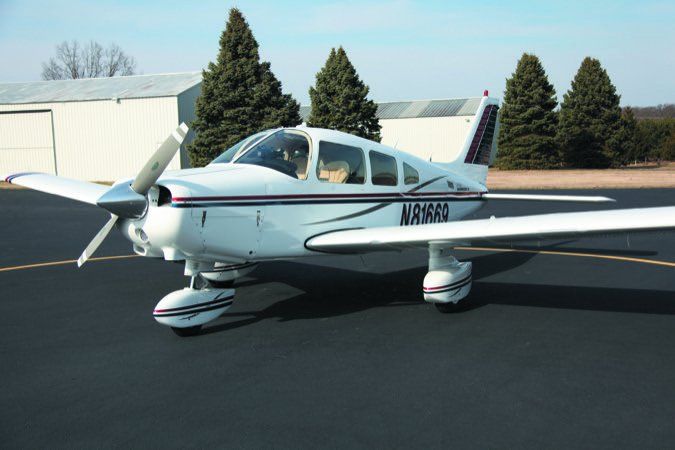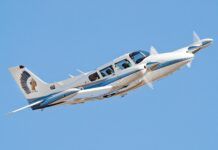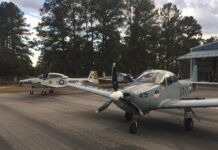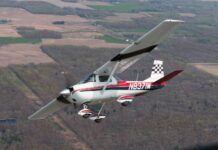For a history lesson on the eventual success of Piper’s Warrior, look back to the alluring post-World War II boom, where major airplane manufacturers, to include Aeronca, Luscombe, ERCO, Piper and Cessna, among others, all eventually came to the conclusion that the future for mass-marketing airplanes was wrapped up in something that had four seats and on the order of 150 HP. Some manufacturers gave up after limited success, while Cessna and Piper went on to fight it out for decades, as Beech and Grumman-American tried to make inroads.
That four-seat, 150-HP niche proved to be the beginning rung of a market ladder where airplanes can excel as trainers, but can also be practical traveling tools. As a Warrior proves, the tradeoff is they won’t haul a lot of people or cargo, nor will they do it quickly, but they offer economical travel. They often serve as a pilot’s first “real” airplane after primary training. The market demands that they be reliable, inexpensive to operate and relatively easy to fly. They must excel as rental airplanes-thus be designed to be flown by any pilot, and withstand the consequent beating, while providing a reasonable income to the FBO.
Against the Cessna Skyhawk, the Piper PA-28-151 or -161 Warrior came a respectable second in the race. It, and the AGAC AA-5 Traveler/Cheetah, are good, solid airplanes that can be had for budget dollars. But it wasn’t an easy climb.
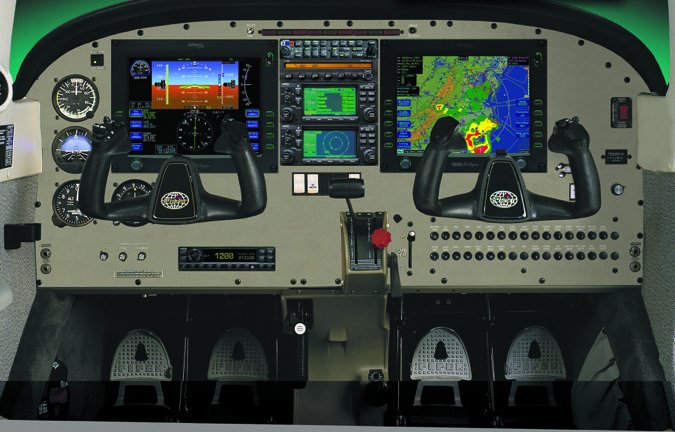
The AA-5 went the way of the dodo in the late 1970s, and attempts to resurrect it (in the form of the Tiger) failed. Beginning in the mid-1980s, Piper, too, fell on hard times and was forced into bankruptcy, finally emerging several years (and a few abortive buyout attempts) later as The New Piper, although “new” was dropped from the company’s name.
Today, all seems quite good at Piper. This past spring it even introduced the new $259,000 Pilot 100 model aimed at smaller flight schools.
Unlike the Skyhawk, and with only one or two exceptions, the Warrior has been in production throughout, even if the number of airframes manufactured in its last several model years could be counted on one hand. In the “Warrior III” configuration, the model was marketed mainly as a trainer before quietly disappearing from Piper’s lineup a few years ago, even if many have been a flight school favorite since its inception. Equipped with a Garmin G500, plus a GTN650 touchscreen avionics suite, ADS-B system and other modern electronics, the newest (2016) Warrior has an average retail price of $260,000, according to Aircraft Bluebook.
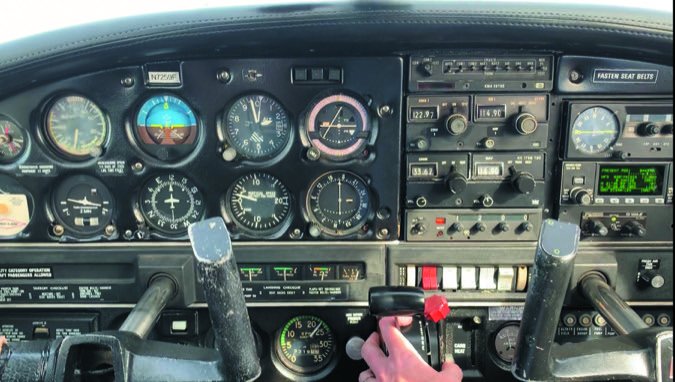
A glance at current prices of mid-1980s Skyhawks and Warriors shows that PA-28-151/161 prices have closed some of the historical gap with the Skyhawk, but are still a relative bargain: The 1984 Cessna 172P II averages $10,000 more than a 1984 Piper Warrior (which averages $35,000 retail), according to the Aircraft Bluebook.
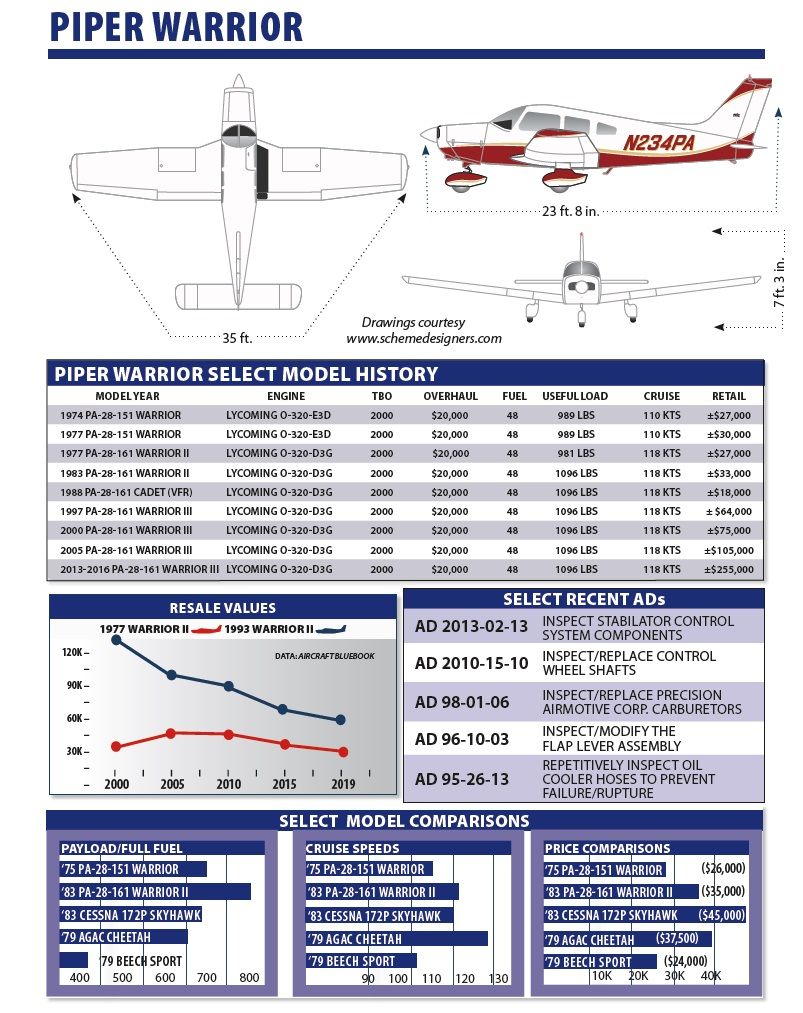
History/Performance
As general aviation was entering its heyday of the 1970s, Piper’s line was beginning to look dated. The basic PA-28 had come out in 1962, and hadn’t changed all that much. Piper’s PA-28 and -32 singles all had the characteristic, constant-chord “Hershey bar” wing, and the company was about to lower the boom on the sleek Comanche. It was time to update the line.
A new airplane was planned, one that would take aim squarely at the Skyhawk. Previously, Piper didn’t really have a strong competitor for the Cessna 172, even though it offered Cherokees with 150 or 160 horses through most of the 1960s. The Cherokee 140 was more cramped, being more of a 2+2 airplane than a true four-place, and it didn’t perform as well as the Skyhawk.
The first Warrior was introduced in 1974, powered by a 150-HP Lycoming O-320-E3D engine. It didn’t replace the Cherokee 140, though the 140 did succumb to poor sales after the 1977 model year.
The Warrior boasted one big difference: a new, longer, semi-tapered wing with a higher aspect ratio. This new wing helped the handling, with lighter roll control forces, and also boosted the climb rate. It also helped the airplane’s looks. The new wing design first appeared on the Warrior, but eventually found its way into all of the PA-28 series as well as onto the PA-32.
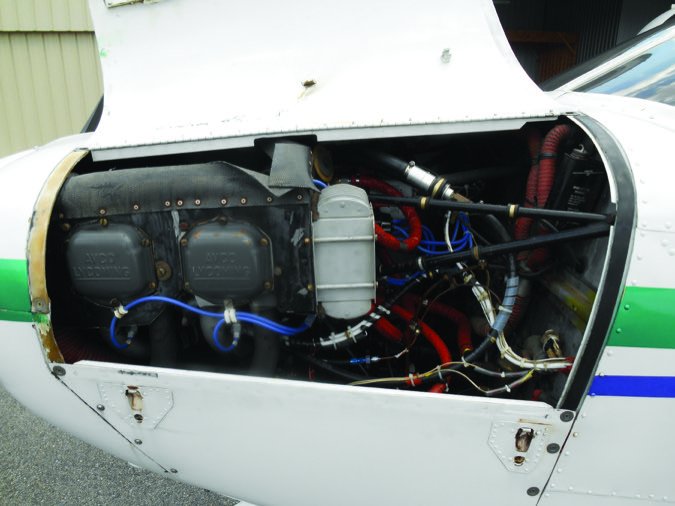
Interestingly, the new design represented a deviation from the production efficiencies originally touted as a virtue of the constant-chord wing. And it’s fun to recall some Piper engineers, back when it was introduced, boasting that the fat, new, stubby wing was actually every bit as good as the sexier-looking tapered Comanche wing, aerodynamically. Piper’s most significant upgrade to the Warrior came in 1977 when a slightly different O-320 engine-the -D3G-was bolted on, offering a 10-HP boost in output. The results were dubbed “Warrior II.”
A couple of other evolutionary changes occurred in 1978, when Warriors received more streamlined wheel fairings, and in 1983, when the battery was removed from under the rear seat and placed in front of the firewall. The new fairings-aftermarket versions of which are available under STC-yielded some 7 knots in cruise speed, according to the book (optimistic numbers, users tell us), while the battery change shortened the run to the starter and helped combat starting problems (though these had been largely overcome, according to users, by swapping copper for aluminum cables).
Thanks to the change in weight and balance, shifting the battery location allowed the gross weight and useful load to be hiked by 115 pounds, and extended the aft CG to allow more of a load in the baggage compartment. (The boost is available via STC for older Warriors.)
An attempt to create some interest in a moribund new-airplane market was made in 1988, when Piper released a version of the Warrior, targeting flight schools, called the Cadet. A stripped-down Warrior, it was available in VFR and IFR versions. The experiment continued through the 1994 model year. Another spruce-up resulted in the Warrior III in 1995, which remained in production through 2012.
Today, a 2012 Warrior III with standard equipment will set you back $289,900, while an average 1974 model brings about $25,000.
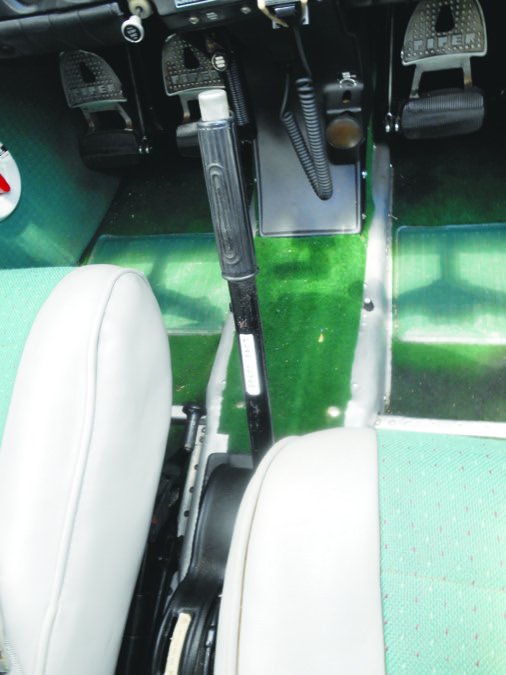
The 10-HP boost in power raised the published 75% cruise speed from 116 knots to 121 knots. And the new speed fairings nudged that up to a claimed 127 knots-not exactly blinding, but squarely in league with the Skyhawk, even if easily eclipsed by the Cheetah. Owners told us in no uncertain terms that real-world performance is well less than the book figures: Owners of the 160-HP model reported cruise speeds from 110 to 120 knots. On the good side, the fuel burn at 100 knots can be as low as 8 GPH.
One big gripe by owners of the 150-HP model is a miserable climb rate. “It’s taken me to 292 airports in 35 states. As a jack of all trades (master of none), it does not climb rapidly, carry a lot of weight or go fast,” wrote one owner of a 150-HP model.
One of the nice features is a generous 50-gallon fuel load (with 48 gallons usable). Burning 7.5 to 10 GPH at cruise, these birds yield a fairly good range with four to six hours of flying. One pilot said he flight planned for 4.5 hours with a 45-minute reserve, and one appreciated the endurance when IFR.
Another owner wasn’t happy, saying, “There are times when 50 gallons has been limiting, and I would have liked to have had at least 72 gallons, as did some of the Arrows.”
Runway performance is adequate, with an owner of a 160-HP model reporting his being flown from a grass runway. He says the airplane is “adequate for the 2600-foot strip. I’m careful with four passengers on high density altitude days,” however, especially if the grass hasn’t been mowed.
Comfort/Loading

While past respondents rated comfort only as average, the current consensus is it’s quite good. Later Pipers benefit from having some of the best seats in general aviation, from both a comfort and crashworthiness standpoint. These seats are designed with an S-tube frame similar to the legendary JAARS seat, which progressively deforms during impact, absorbing energy before it reaches the occupant. For greater pilot comfort, there is an optional vertical seat adjustment that some say is great, but others say is prone to malfunctioning.
The fuel selector is located out of sight alongside the pilot’s left knee. The need to switch tanks left and right results in more fuel mismanagement accidents than with the “both tanks” system on the high-wing Cessnas, judging from the accident reports. Naturally, it’s also easy to develop an imbalance unless the pilot remembers to switch regularly, and there is no aileron trim for the airplane. This makes at least a wing-leveler autopilot a nice option, in our opinion.
The Warrior’s parking brake is a robust handle sticking out from the bottom of the panel. It’s simple and strong, and it works. The same goes for the flap system. It’s manual, positive, blessedly simple and it just doesn’t break.
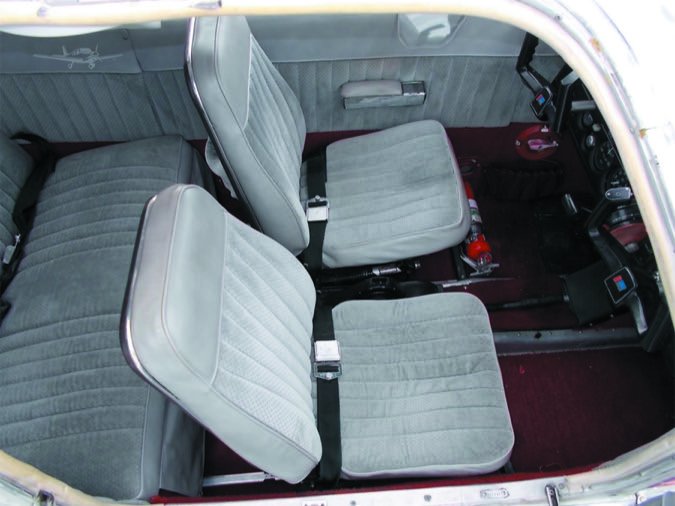
Like most low-wing aircraft, however, entry and exit is awkward. The Warrior has only one door, so three of the four occupants have to do some contortions to get in place. Emergency egress is problematical, since the rear windows cannot be opened in an emergency (like those of some Bonanzas, for example). The Warrior’s baggage door is fairly large, however.
Naturally, with a full load of 50 gallons, the Warrior won’t carry four adults, but some owners report fueling up only to the tabs (34 gallons), accepting the reduced range and legally flying off to their destination. The baggage compartment will take a full 200 pounds structurally, the same as more powerful PA-28s. That’s a lot more than the Skyhawk and Cheetah’s maximum of 120 pounds, by comparison.
Most owners say nice things about cabin ventilation, thanks to an abundance of outlets, both overhead and underneath. Unfortunately, there were complaints that in winter the overhead vents were too much of a good thing and could not be completely shut off, giving passengers the chills. Pilots have solved this problem by simply taping up the exterior air inlet on the tail in the winter. We also received reports of the heater baking the ankles of those in front while rear passengers froze.
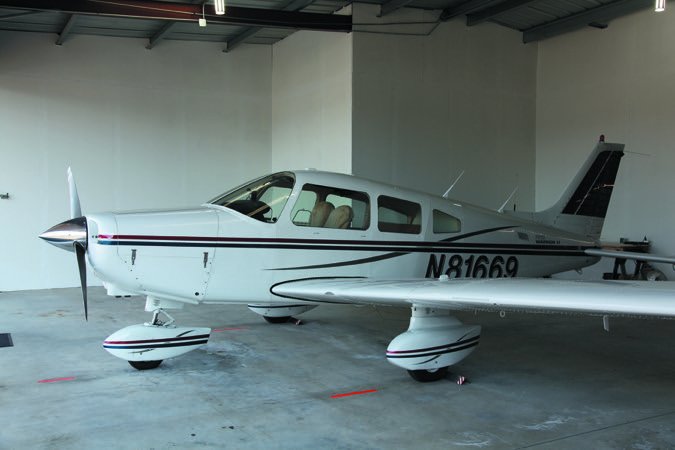
A few owners had the air conditioning systems available as options on the Cherokee line. Those who did felt the cool air yield in summer was not worth the sacrifice in already-limited payload and performance.
Handling/Competition
The Warrior shares with the other Cherokees a gentle nature, pleasant handling and such a reluctance to stall aggressively that some pilots rate it a poor teacher. Several respondents said that with both rudder and stabilator trim, the airplane does not need an autopilot.
We’d rate runway handling as good, despite the number of accidents on both takeoff and landing-especially landing-we uncovered in past checks of FAA accident and incident reports. Further investigation revealed that many were student training accidents.
Pilots report they like the way the aircraft handles in a crosswind landing and feel more secure taxiing in windy conditions with the wide gear stance, as opposed to operating in the high-wing Cessnas.
The Cessna Skyhawk and the AGAC Traveler/Cheetah are the most logical competitors to the Warrior for the attention of buyers who want four-seaters that won’t break the bank and who are willing to settle for modest performance.
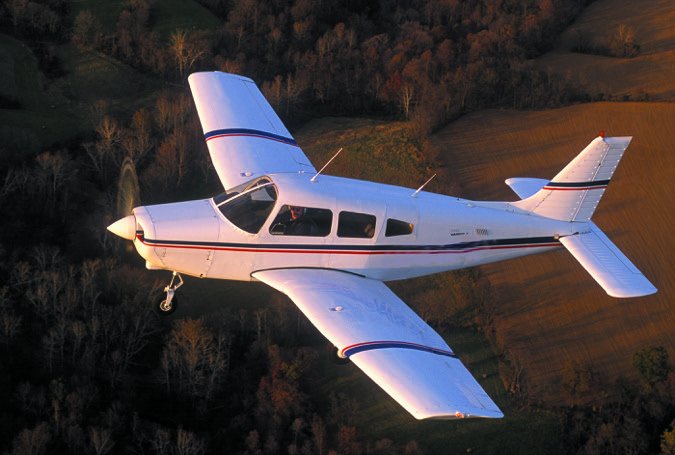
The Cessna has by far the best overall safety record. In a cross-country race, the Cheetah would edge out a 160-HP Warrior with the later wheelpants (the Traveler is slower), and leave the Cessna and the older Warriors in its propwash. And while the Traveler/Cheetah has the most pleasant, facile handling, in our book, it is not as adept at handling short fields. The Cessna gets our nod for getting in and out of little runways.
Maintenance
Here’s where the Warrior should shine, since it’s the opposite of high-tech sophistication. It’s got fixed gear, a fixed-pitch prop, mechanical flaps and a small-bore carbureted engine. It also comes with a cowling providing the best engine access in its class: Doors on either side of the cowling are hinged at the top and secured with double latches. By contrast, gaining similar access to a Skyhawk’s engine requires removing several screws and then lifting off the cowling’s upper half, a two-person job when done correctly.
As expected, owners report relatively low maintenance costs and modest annual inspection fees. But it’s a good thing they have that cowling: The engine compartment is the source of most upkeep problems.
Our checks of Service Difficulty Reports (SDRs) showed a host of problems with carburetors and a number of magneto failures. The powerplant itself was tagged with several failure modes, valves being at the top of the list, followed by camshaft/lifter/pushrod problems, cylinder cracks and rocker arm breakage.
Potential buyers should check to see if there is roughness following engine start, since according to Lycoming that’s one sign the exhaust valves are beginning to stick. (The roughness usually goes away after the engine warms up, incidentally.)
High-time Warriors usually got that way as a result of being in a training environment. As one result, landing gear components and attach points, along with their fasteners, are subject to numerous cracks and corrosion.
If you’re looking at a Warrior equipped with air conditioning, take a look at the bracket that attaches the alternator and compressor. We noted reports that the mounting bolts had broken or worked loose. And in one case the submitter found the bracket was installed backward, subjecting the rear tab of the alternator to stress and misalignment of the pulleys.
Mods/User Groups
One series of mods available from Plane Dynamix (www.planedynamix.com) for earlier PA-28 models also can be installed on Warriors. These include a set of vortex generators, modifications to the standard Sensenich prop blade designed to reduce drag, a new, more-efficient cowling and-for -151 Warriors-an upgrade to 160 HP. We have no direct information on these mods’ effectiveness, but Art Mattson (who recently sold the company to Plane Dynamix) has regularly set speed records in his Cherokee 140.
Owners of 1977 through 1982 Warrior IIs can get a gross weight increase, from 2325 up to a whopping 2440 pounds. Mostly a paperwork exercise requiring a placard and carrying a later Piper information manual, the STC gives early -161 owners the same gross weight 1983 and later models enjoy. Ventura Aero (www.ventura.aero) offers this mod.
Another interesting STC involves installing a supplemental storage area under the baggage compartment floor, capable of storing up to 25 pounds. The mod, available from Aircrafters Inc. (www.aircrafters.com), includes parts and paperwork for the conversion.
Other mods include ones from LoPresti Speed Merchants (www.speedmods.com), Met-Co-Aire (www.metcoaire.com) and Knots 2U (www.knots2u.com). These include gap seals and new wingtips-including tips with landing/recognition lights.
As with any personal airplane, we strongly recommend joining its type club. The expertise can save real money when tracking down common parts and problems. Warrior owners are fortunate in that they have an excellent organization, the Piper Owner Society (www.piperowner.org), which merged with the Cherokee Pilot’s Association. There is also a Piper Forum (www.piperforum.com) where Piper pilots exchange thoughts.
Warrior Wrecks: Other, Rloc
We’ve long thought Piper hit a home run when it tapered the wing of the Cherokee 140 and turned it into the Warrior. Our review of the 100 most recent Warrior accidents tends to support that opinion as there is no glaring shortcoming that shows up among the bent metal.
The fact that Warriors are widely used for student training appears in the numbers for landing accidents-although at 36 percent of all accidents, the rate is certainly not high. Runway loss of control made up only 17 percent of all accidents-a decent showing and a reflection, in our opinion, that the wide-track landing gear makes for good ground handling overall.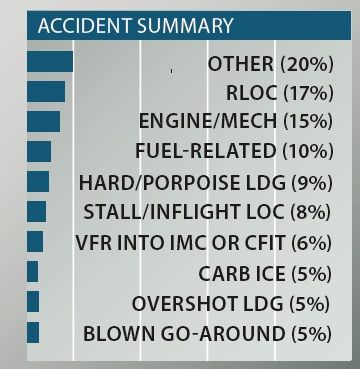
On the “oops, the landing isn’t going well, it’s time to go around” front, we have good and bad news. The good news is that we normally see situations where pilots let the airplane get seriously out of control-45 degrees and more off runway heading-before going around and hitting obstructions off to the side of the runway. We didn’t see any wild heading excursions, a tribute to the airplane’s handling.
On the bad news side of making a go-around in a Warrior, we have to address the manual, or “Johnson Bar,” flaps. For decades we have heard pilots praise manual flaps and complain about slow-acting electric flaps. They like the instant ability to increase flap deflection. That’s all well and good, but the dirty little secret of manual flaps is that pilots have a tendency to screw up and retract them all at once rather than a bit at a time.
Five Warrior pilots (some were students) were doing fine on a go-around until they dumped all the flaps at once. In each case the airplane stopped climbing-or started descending-and smacked into an obstruction. When dealing with manual flaps, retract them gradually on a go-around.
There were only 10 fuel-related accidents, about what we expect in an airplane where a pilot has to change fuel tanks in flight to get at all of the fuel aboard. While some pilots ran completely out of fuel, several ran a tank dry with plenty of fuel in the other and either didn’t even try to change tanks before the subsequent landing or didn’t follow the procedure in the POH.
The engine stoppage events were split about half and half between poor maintenance and “we can’t explain it.” The Lycomings in the Warrior have a reputation for not developing carburetor ice. However, there were five accidents resulting from carb ice. The Cessna 150 and 182 have a reputation for developing carb ice, so pilots are ready for it and there are few accidents. We think that Warrior pilots should be a little more spring-loaded to activate the carb heat when there is a power interruption than they are now.
If it’s possible to feel sorry for a machine, we did for the Warriors plagued with such things as a pilot who didn’t check Notams to find out the new Unicom frequency at his destination airport. Arriving well after dark he couldn’t activate the pilot-controlled lighting. He decided to land anyway-in a ditch between the runway and taxiway. All went reasonably well until he hit a culvert.
Another Warrior driver decided to fly low over mountains at night. He “felt impacts on the left side.” After landing he discovered he’d hit trees and fractured the wing spar.
Owner Feedback
I have owned my 1980 Warrior II since the year 2000 and I have found it to be a great airplane. The Warrior is not a stretched Cherokee 140. It is a different aircraft and flies much differently.
While the Warrior fuselage is longer and has full rear seats, the Warrior II has a 160-HP Lycoming 0-320 engine, and most significantly the “Warrior wing,” which is far different than Hershey bar wings. This wing is longer than an A-36 Bonanza’s, and flies significantly different than any of the Hershey bar wings.
With the longer wing the plane glides beautifully. It’s really remarkable. In Hershey bar-wing aircraft the ground comes up quickly with power back. Not so in the Warrior. With the larger wing, however, holding the yoke way back with an overly high AOA on the initial ground run for soft-field and short-field takeoffs is the incorrect procedure and increases the ground roll, so it’s important to read the POH when transitioning to the type.
I have found the fuel system to be much better than the “both” cross-feed system on some other aircraft. The low-wing Warrior is easy to fuel and there’s a 50-gallon capacity (48 usable), with a tab for partial fills. No bladders mean no fuel leaks. The fuel gauges don’t fluctuate and are just as accurate as the gauge in my car. I also have a calibrated dipstick for partial fills, which is remarkably accurate. Between accurate fuel burn rates, confirming gauges and dipstick measurements, I always know exactly how much fuel is where.
The fuel selector is simple to operate with well-defined detents and a stop to prevent inadvertent shut-off. Switching tanks is a non-event, and shutting the fuel completely off requires a deliberate and different action than switching tanks.
My O-320 engine has been quite reliable and it always starts easily-hot or cold weather. It uses less fuel than the O-360 and seems to run smoother. My engine has roller tappet lifters. If you change the oil regularly and maintain the engine, there are no issues with stuck valves, or magneto failures, and the engine cases generally don’t crack. The last engine in my aircraft easily made it past the 2000-hour TBO. Obviously, aircraft with crankcase oil that looks like taxiway sealant have issues not normally seen.
I have never needed to use carburetor heat on this engine in any weather, unlike some Continental-powered aircraft where carb ice might be a regular problem.
The cabin door is curved to integrate into the fuselage roof. This clamshell shape gives the door torsional rigidity and it has two points of closure with the top latch so the door closes like a bank vault. If the door seals are well maintained for both the cabin door and the baggage door, the cabin seals nicely with no wind noise or cold drafts. There is plenty of heat available so the back seaters are quite comfortable. Personally, I think the design and build quality of these Pipers is better than Cessna. My plane has no cracked or broken interior plastic.
My aircraft flies beautifully, trims out perfectly and easily makes book numbers. My plane has a new paint job, plus all the wheel pants and fairings (including the nose strut fairing) that came with the plane from the factory, so the plane is aerodynamically clean. Flight school Warriors are typically missing all the pants and fairings for quick maintenance, and the airframes are often in poorer aerodynamic condition so their performance is different. If a thin layer of winter frost can reportedly reduce lift by as much as 30 percent and increase drag by as much as 40 percent then a sandpaper paint finish might do the same thing.
The Warrior has no prohibition on slips with or without flaps. I typically slip and land with two notches of flaps. Forward slips, turning slips and side slips for crosswind landings all work very well. This plane has a pretty high 17-knot demonstrated direct crosswind capability. With the dihedral low wings, crosswind landings are routine and easy. This plane works with you not against you. I don’t believe that planes get any easier to fly than this one. However, I believe many accident stats for this aircraft are more often reflective of low-time student mishaps than any fault with the plane.
My Warrior, by way of an STC, has a gross weight increase to 2440 pounds which is really just a paper-work correction to the original POH. The useful load on my aircraft is 921.5 pounds-quite decent-and means I can carry three 200-plus-pound adults (myself included) with full fuel for four hours (more than I need) plus one hour of reserve fuel. I believe this plane has better performance than a similarly powered Cessna 172. Fuel burn at high power settings is around 9 GPH, but powered back for sightseeing the burn drops to around 6 or 7 GPH.
The base cost for annual inspections is around $1200 and full insurance is $950. I’m a retired senior and have found this plane to be an excellent retirement plane. This plane was intentionally designed to be economical and easy to maintain and it fulfills that mission.
It’s a well-behaved sweetheart, with no bad habits, that is easy to own and operate on a retirement budget.
Tony Esteves
via email
I have a 1979 PA-28-161 Piper Warrior II. It’s a pretty straightforward airplane with really no bad habits or surprises. It doesn’t do any one, single thing very well but does many things pretty well. It’s a stable, easy to fly airplane and normal and crosswind landings are a breeze. Plus, the manual flaps are simple and reliable.
It’s also a pretty easy plane to maintain as most mechanics have experience working on them and parts are easy to obtain. The 160-HP Lycoming O-320 is about as simple as you can get and the Warrior’s engine cowling provides great engine access during preflight and maintenance.
At present my Warrior II has older IFR avionics that I am considering upgrading, along with looking into ADS-B. It has a new interior and all-new Plexiglas but could probably use a new paint job at some point
I plan on an honest 110- to 115-knot cruise speed at 8 GPH without wheel fairings. My useful load is just over 850 pounds. The 48-gallon fuel tanks can be partially filled to the tabs (17 gallons per side) allowing for more cabin payload
The single door on the right-hand side really isn’t an issue, but I would prefer one on the left, and maybe a push-out window for emergency exit might be nice to add to my wish list.
The baggage compartment can hold 200 pounds, which is 80 pounds more than the Cessna 172. Overall performance is similar to if not a bit better than a Cessna 172.
Maintenance hasn’t really been too bad, with annual inspections and maintenance running around $2000-$3000 per year. The tie-down is $60 per month and my insurance runs just over $500 per year for a $40,000 hull value.
Of course everyone wishes their plane was faster, bigger, could carry more and had more range. Still, the Warrior II is really a good compromise. As with any aircraft, if you are considering buying one make sure you have a competent mechanic do a pre-purchase inspection on it, while outstanding ADs aren’t too bad. Corrosion on the older airframes could be an issue so be diligent on looking for it and correcting it. Piper Service Bulletin 1006 suggests and encourages that you remove the fuel tanks every seven years for inspection. There is a proposed AD out that might require wing spar inspections on certain Piper airframes and, if eventually implemented, could be significant depending on how it is actually written.
Mitch Ross
via email

